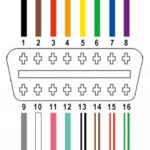Tesla Model 3 and Model Y don’t have a standard OBD2 port like most gasoline cars. Instead, they use a proprietary diagnostic port located beneath the center console in the rear passenger area. This port requires a special adapter to connect with standard OBD2 diagnostic tools and software.
Accessing Tesla Diagnostic Data with an OBD2 Adapter
Accessing the diagnostic data on a Tesla Model 3 or Y requires two things: a Tesla-compatible OBD2 adapter and an ELM327 or STN1110 compatible OBD2 scanner or Bluetooth device. Popular choices for OBD2 tools include the OBDLink LX and MX. While various adapters are available, a reliable option is the OHP OBD2 Adapter specifically designed for Tesla Model 3 & Y (2019-2020 builds).
Due to Tesla’s robust security systems, accessing the diagnostic port primarily allows for reading live vehicle data. Modifying vehicle settings or critical functionalities isn’t possible through this connection.
Popular Tesla Diagnostic Apps: Scan My Tesla and TM-Spy
Two popular apps for displaying live Tesla data are Scan My Tesla and TM-Spy, both available for Android and iOS devices.
Scan My Tesla: Comprehensive Live Data
Scan My Tesla provides a wide range of live vehicle statistics, including:
- Battery: power, voltage, current, and temperatures
- Drive Unit: electric power, torque, horsepower, RPM, and temperatures
- Battery Health: lifetime stats, capacity estimates, and mileage
- 12V System: current, voltage, and temperature
- Trip Data: recording and statistics, including charging sessions
- HVAC: controls and readings
Here’s a video demonstrating Scan My Tesla in action by Bjørn Nyland:
TM-Spy: In-depth Battery Analysis
TM-Spy focuses on detailed battery information, displaying:
- Individual Cell Voltages: readings for all battery cells (84 or 96 depending on battery pack size)
- Voltage Extremes: maximum, minimum, and the difference between them (delta)
- Battery Balance: a histogram visualizing the balance of the battery pack
- Temperature Sensors: readings from 16 pairs of inlet/outlet coolant temperature sensors
- Battery Performance: total voltage, current during driving and charging, pack capacity, remaining energy, mileage, and lifetime energy usage
Here’s a TM-Spy demonstration by David Drives Electric:
The Tesla Model 3 CAN Bus Data
The data utilized by these apps is largely sourced from the Tesla community’s collaborative efforts in identifying and documenting the Tesla Model 3’s CAN bus IDs and data. This valuable information is available in a publicly accessible document. The dedication of the Tesla owner community has made these diagnostic tools and insights possible.

